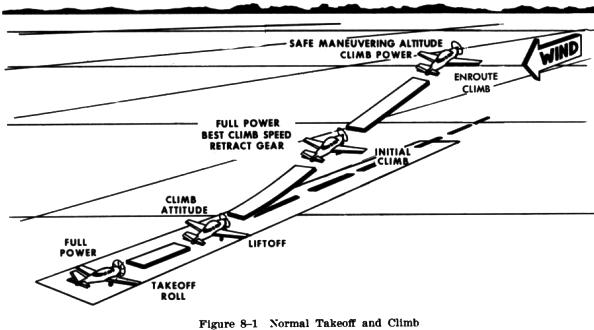
The takeoff and departure climb involves the movement of the airplane from its starting position on the runway to the point where a positive climb to a safe maneuvering altitude has been well established. Since the takeoff requires both ground and in-flight operation, the pilot must be able to use the controls during the transition from ground functions to in-flight functions with maximum smoothness and coordination. Skill in blending these functions will improve the pilot's ability to control the airplane's direction of movement on and from the runway.
A thorough knowledge of takeoff and climb principles, both in theory and practice, will prove to be of extreme value throughout the pilot's career. It often may prevent an attempt to take off under critical conditions that would require performance beyond the capability of the airplane or the skill of the pilot. The takeoff itself, though relatively simple, often presents the most hazards of any part of a flight. Accident statistics show that takeoff accidents, although slightly less in frequency of occurrence, are much more tragic than landing accidents. Consequently, the importance of a thorough knowledge of the principal factors involved, and faultless technique and judgment cannot be overemphasized.
Takeoffs should always be made as nearly into the wind as practical. There are two reasons for this - first, the airplane's speed while on the ground is much less than if the takeoff were made downwind, thus reducing wear and stress on the landing gear; and second, a shorter ground roll and consequently much less space is required to develop the minimum lift necessary for takeoff and climb. Since the airplane depends on airspeed in order to fly, a headwind provides some of that airspeed, even with the airplane motionless, by reason of the wind flowing over the wings.
Although the takeoff and climb process is one continuous
maneuver, it will be divided into three separate steps for purposes of
explanation: (1) the takeoff roll, (2) the liftoff, and (3) the initial
climb after becoming airborne (Fig. 8-1).
The takeoff roll is that portion of the takeoff procedure
during which the airplane is accelerated from a standstill to an airspeed
that provides sufficient lift for it to become airborne.

The liftoff, or rotation, is the act of becoming airborne as a result of the wings lifting the airplane off the ground or the pilot rotating the nose up, increasing the angle of attack to start a climb.
The initial climb begins when the airplane leaves the ground and a pitch attitude has been established to climb away from the takeoff area. Normally it is considered complete when the airplane has reached a safe maneuvering altitude, or an enroute climb has been established.
The normal takeoff is one in which the airplane is headed directly into the wind or the wind is very light, and the takeoff surface is firm with no obstructions along the takeoff path, and is of sufficient length to permit the airplane to gradually accelerate to normal climbing speed.